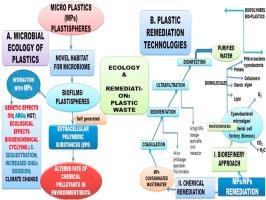Journal of Cleaner Production ( IF 9.7 ) Pub Date : 2020-11-24 , DOI: 10.1016/j.jclepro.2020.125240 Prabhat Kumar Rai , Jechan Lee , Richard J.C. Brown , Ki-Hyun Kim

|
An abrupt rise in plastic waste has become one of the most serious global environmental problems during the past five decades, and many strategies have been suggested to control the increasing levels of contaminants associated with plastic waste. Although many studies have focused on the fate, transport, ecotoxicity, and health risks of plastic waste contaminants, only a few studies have investigated microbial remediation of contaminants using cutting edge nanoscience. This review aims at addressing the environmental problems caused by microplastic (MP) and nanoplastic (NP) particles in the context of nanoscience (e.g., synthetic nanoparticle–plastic integrated research), microbial ecology, and remediation technologies to help elucidate their environmental fate, behavior, transport, eco-toxicity, and management. Interactions between plastic and microbes generally cause biofilm formation, which has biological effects that range from genes (by influencing horizontal gene transfer) to whole ecosystems (by influencing biogeochemical cycling, carbon (C) sequestration, and climate). Plastic waste remediation via chemical and bio-nanotechnologies (e.g., coagulation, membrane bioreactors, biodegradation, and phytoremediation) are also reviewed. In this respect, thermochemical conversion of plastic waste into energy is a promising management option. Further, molecular and -omics technologies can also facilitate the microbial biodegradation of MPs/NPs by enhancing enzymatic activity levels. A strategy based on proper incorporation of such interdisciplinary researches with robust sustainable policy measures is expected to offer effective management tools for the plastic wastes in the environment.
中文翻译:

微生物和纳米塑料污染:行为,微生物生态学和修复技术
在过去的五十年中,塑料废料的突然增加已经成为最严重的全球环境问题之一,并且已经提出了许多策略来控制与塑料废料有关的污染物水平的增加。尽管许多研究集中在塑料废物污染物的命运,运输,生态毒性和健康风险上,但只有少数研究使用前沿的纳米科学研究了微生物对污染物的修复。这篇综述旨在解决在纳米科学(例如,合成纳米颗粒-塑料集成研究),微生物生态学和修复技术等背景下由微科学(MP)和纳米塑料(NP)颗粒引起的环境问题,以帮助阐明它们的环境命运,行为,运输,生态毒性和管理。塑料与微生物之间的相互作用通常会导致生物膜形成,其生物学影响范围从基因(通过影响水平基因转移)到整个生态系统(通过影响生物地球化学循环,碳(C)固存和气候)。还回顾了通过化学和生物纳米技术(例如,混凝,膜生物反应器,生物降解和植物修复)对塑料废物的修复。在这方面,将塑料废物热化学转化为能源是一种有前途的管理选择。此外,分子和组学技术还可以通过增强酶活性水平来促进MP / NP的微生物生物降解。











































 京公网安备 11010802027423号
京公网安备 11010802027423号